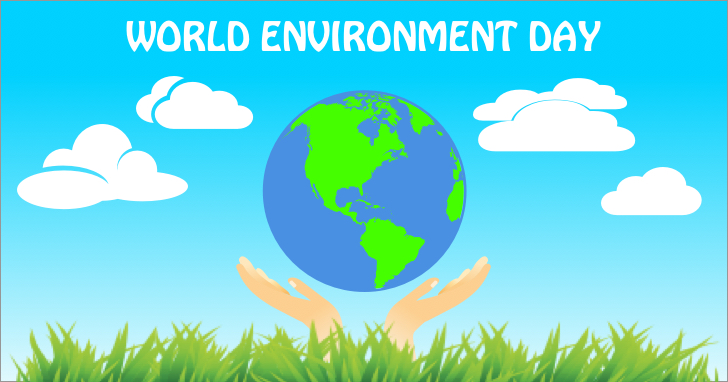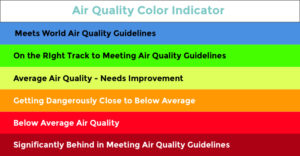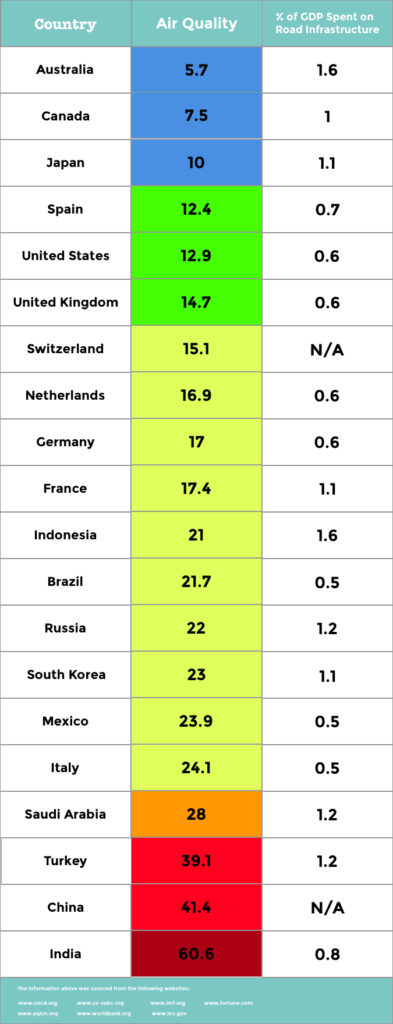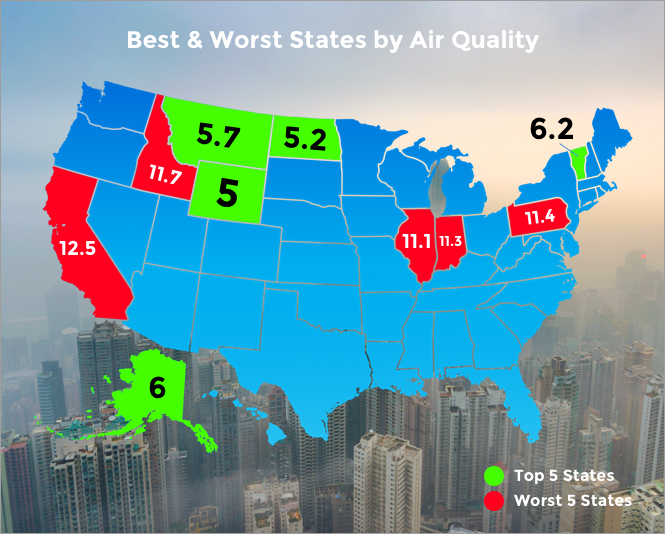Why Is the United States Spending $62 Billion?

June 5 is World Environment Day (WED), a day organized by the United Nations for “encouraging worldwide awareness and action for the protection of our environment. Since 1974, WED has functioned as a platform for public outreach on ecological concerns and calls for action to protect the global environment.
To honor World Environment Day, we took a look at a piece of the global system that we are familiar with at Obrella: our roads and infrastructure. We know that the emission of CO2 related to transportation, including fumes from the vehicles that we drive, account for a big portion of the total greenhouse gas—26 percent, to be exact.
We also know that human-caused CO2 emissions contribute to the total effects of climate change and air quality, which could have devastating results on our global environment and our lives. For this reason, we think it’s important to look at possible links of air quality and climate change to global transportation and infrastructure.
This led us to wonder if the amount that a country (or state) spends on infrastructure and public transportation might be related to the air quality in that particular geographic area. We gathered all sorts of data, including gross domestic product (GDP) by nation, international transportation and infrastructure information, air quality indexes by country and U.S. state, public mass transit data, and more (you’ll find specific data sources at the bottom of this page).
Take a look at the data and our research to see if our hypothesis that public infrastructure spending correlates to air quality held water. Regardless of the results, we think the question was worth looking at and led to some more questions that we’d love to dig into down the road.
World Environment Day: Are Public Infrastructure Spending and Air Quality Related?
In our research on the global scale, we looked at the top 20 countries by GDP and at how much each spends on road infrastructure. There are two ways we organized the information: by each country’s total dollars spent (in a given year) and as a percentage of its GDP.
We then pulled each country’s air quality measurement, which is represented as an index (AQI). The AQI measures fall into a spectrum how closely they meet air quality guidelines set by the World Health Organization (WHO). Countries’ AQIs range, from best to worst, from “on the right track” to “significantly behind” for meeting the guidelines.
Here’s the global data organized by country:

Enter your zip code below to view companies that have cheap insurance rates.
Secured with SHA-256 Encryption
Australia Top’s The Richest Countries With the Best Air Quality
It’s hard to draw definitive conclusions from this data. We do see that some of the highest spenders on infrastructure by dollar amount (Japan, U.S., Canada, and Australia) have some of the best AQI measurements. Australia is the highest spender and has the best air quality.
On the other hand, the same can’t be said if you look at the data by percentage of GDP. For example, the United States spends more than $61 billion on roads a huge amount of money but that amount only accounts to 0.6 percent of the country’s GDP. From this angle, the United States is one of the lowest spenders among the 20 largest nations. And by the data, the United States has some of the best AQI measurements of any country.
Another discrepancy: China spends the most dollars—$207 billion—but has some of the worst air, while Japan spends $107 billion and has one of the best AQIs.
This ambiguity could be due to several other factors. Possible answers include:
- The number of cars owned by population
- Public transportation usage
- Energy efficiency, recycling, and other waste-reduction efforts
- The types of energy used like coal, nuclear, solar, etc.
- Other, non-human environmental factors, like geographic and weather phenomena
United States Study
Now let’s look at the data from the United States For this research, we used the percentage of each state’s spending on transportation of total expenditures. For air quality, we used each state’s rating from americashealthrankings.org that ranks them by their citizen’s average exposure to particulate matter.
Three of the top six highest spenders on infrastructure rank in the top for air quality (North Dakota, Alabama, and Montana). But the data this relationship doesn’t hold true for the bottom of the list. The five states that spend the least on road infrastructure have about average air quality by these measurements.
The question again becomes: What other factors could play into air quality? If public spending does have an effect on air quality, in what cases would that be true?
Maybe we would see a stronger correlation if we looked more specifically at large cities or metropolitan areas. After all, some big states by geographic size, like California, also have a large number of major metropolitan areas where more people live and drive. But these areas also may have higher degrees of public transportation use, which we would expect to drive up air quality.
These are questions we would enjoy looking into in the near future, so stay tuned.
The Effects of Air Quality
Why look at this information at all? For one, our air quality can have significant effects on our lives. An entire article could be written (and they have been!) on the consequences of poor air quality. Air pollution puts our health and lives at risk. Poor air quality increases the risk premature death in infants, and of many health conditions in children and adults like:
- Stroke
- Heart disease
- Lung cancer
- Asthma and other respiratory diseases
Clearly, the risks of enduring bad air are high. That’s why we think it’s worth trying to do something about it.
Read more: Securing Life Insurance For Cancer Patients
Enter your zip code below to view companies that have cheap insurance rates.
Secured with SHA-256 Encryption
What You Can Do
Combatting poor air quality and the effects of climate change is admittedly a cause that appears larger than anything one person can do. Certainly, countries and states will need to come together with solutions to these problems that will improve our health and lower the risks associated with air quality.
Even so, there are things that you can do. For one, you can educate yourself. There are plenty of resources online from everything from air quality data to infrastructure spending to public mass transit. We recommend any of the sources we’ve mentioned and those we’ve included at the end of this page. Knowing about the problem is the first step in changing it.
You may also want to consider your own contributions of CO2 emissions and other greenhouse gases. Find out first what your “footprint” is by using a calculator like this one from the Environmental Protection Agency (EPA). The EPA site also gives you suggestions for ways to reduce your own CO2 footprint.
States may have a part to play in that they determine how infrastructure dollars will be spent. Some in government and the media are calling for significant increases in infrastructure spending, claiming that it will improve our environment as well as our economy.
Infrastructure, Politics, and Climate Change
What are the major players in American politics saying about the role of infrastructure spending, air quality, and climate change? The truth is that although both of the major parties’ likely candidates are calling for increased public infrastructure spending, their ideas about climate change are dramatically different.
We’ll report to you what Clinton and Trump are saying, and let you decide what you think about their positions.
Hillary Clinton
Clinton takes a hard stance about climate change. She believes that the “science is settled” and that human actions will lead to negative, direct effects on our environment and our lives. She believes climate change is an “urgent challenge that threatens us all” and encourages action from the government and the American public.
Clinton’s infrastructure plan involves a five-year $275 billion investment by the federal government. Most of this investment will be in public investments, including roads, bridges, ports, waterways, and Internet broadband. The plan also boosts investment in green energy and investments to combat the effects of climate change.
Donald Trump
Donald Trump is virtually on the opposite end of the spectrum from Clinton on the topic of climate change. He has referred to himself as “not a believer” and that recent changes in climate are likely the result of expected weather cycles. For these reasons, trump doesn’t think the U.S. should spend money on a problem that, in his opinion, doesn’t exist.
Trump is a supporter of increased spending on American infrastructure, which he says is “crumbling.” He sees government spending for infrastructure as an economic stimulus through construction. Trump has called for construction of private and commercial buildings, and he supports building high-speed trains in the U.S.
The Bottom Line
We undertook this research because we think it matters. Because CO2 emissions have an effect on our air quality, our health, and on our environment, it’s important to understand the factors at play. Our analysis of the data for infrastructure spending gave us some interesting results, but left us with more questions about what factors are most relevant to the air quality issue. We are bound to see nations and states tackle these problems into the near future, and politics will continue to be tied to the issue. And Obrella will continue to report on these issues when we think it will matter to you.
We’ve given you our analysis and our thoughts about air quality and infrastructure. But we want to know what you think! Share this post with your friends and family on social media to celebrate World Environment Day with us, and tell us what conclusions you draw from the data, and whether you agree with our assessments.
Free Insurance Comparison
Enter your zip code below to view companies that have cheap insurance rates.
Secured with SHA-256 Encryption


